October 26, 2012, restaurant la Nouvelle Auberge, Wihr au Val (France)
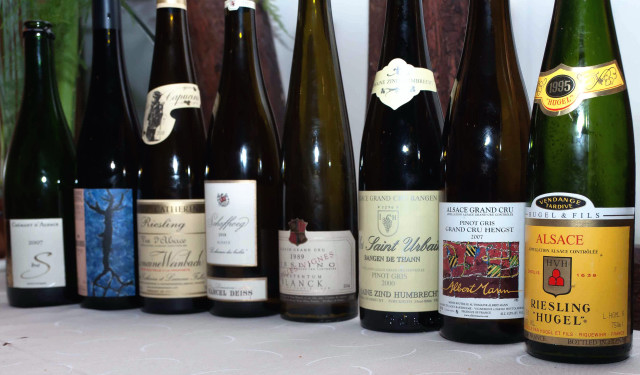
It almost started as a joke in 2010 : after nearly 10 years of organizing dinners and tastings around Alsace wines with L’Oenothèque Alsace, the question popped up: what would be a perfect dinner pairing the very best Alsace wines which with some of the best dishes available? Five months later, it ended up in a fantastic dinner for 60 participants, pairing some of the legendary Alsace wines with a series of five dishes wonderfully prepared by Chef Jean Philippe Guggenbuhl at restaurant la Taverne Alsacienne in Ingersheim
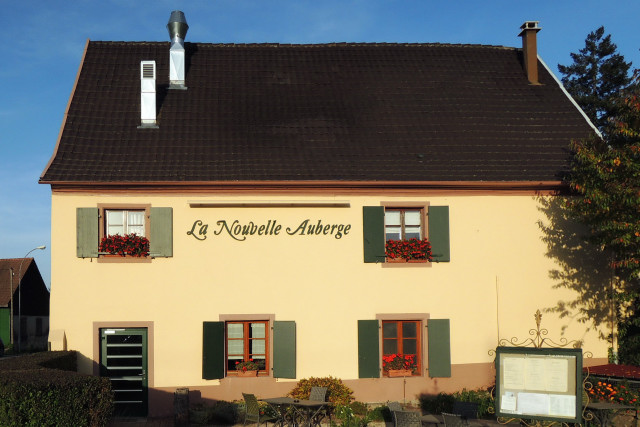
Two years later, the second edition had the same objective, bringing the very best Alsace wines around a wonderful dinner, this time prepared by Chef Bernard Leray, of restaurant La Nouvelle Auberge in Wihr au Val. Based on a fantastic five course meal prepared using local and seasonal ingredients, the wine were selected and provided by L’Oenothèque Alsace. This year I decided to match every dish with a young and more mature wine.
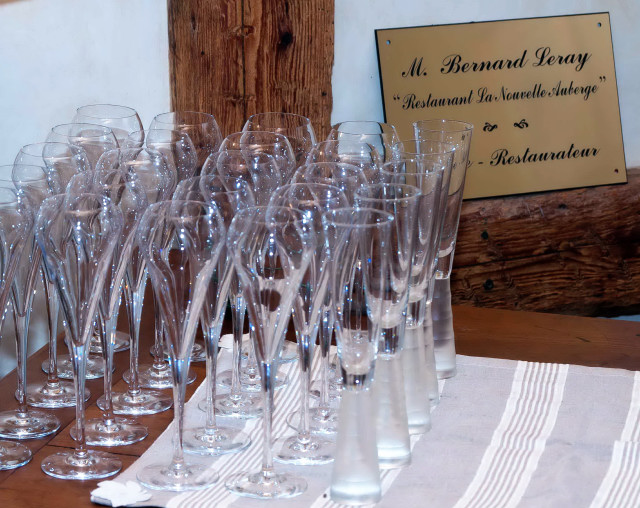
For the Reception: tasting a Crémant d’Alsace 2007 just disgorged from Domaine Schoenheitz
Crémant d’Alsace, the Alsatian sparkling wine, often tries to match the style of Champagne. If this is successfully achieved by growing chardonnay and pinot noir on Alsace’s limestone terroirs, I wanted to start dinner with a crémant somewhat more typical from its appellation. That is, a very aromatic and fruity wine, with a lot of freshness. The Crémant d’Alsace 2007 from Domaine Schoenheitz (a local grower from Wihr au Val), was selected, but only disgorged the day of the dinner, to bring both complexity of long ageing on the lees and maximum freshness from late disgorgement. The Crémant was above all expectations, very tiny bubbles in the glass, very subtle floral aromas, and a very delicate palate giving an incredible sense of balance. With nearly 4 years ageing before disgorgement, this extra brut cuvée is perfect as a reception wine, although it would probably stand the whole meal too.
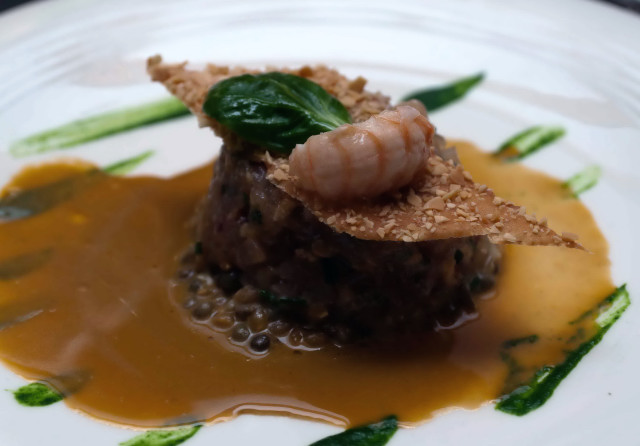
First course: Fresh and smoke Féra (whitefish) tartar, Crayfish vinaigrette and roasted almonds
This first course used a fish coming from Lake Leman between France and Switzerland. This was a perfect opportunity to pair it with granite and sandstones soil terroir wines. If the fresh fish was calling for a young vintage, the addition of roasted almonds and smoked fish was also a good try for mature vintage. I selected Riesling Cuvée Sainte Catherine 2010 from Domaine Weinbach because it comes from the lower part of the Schlossberg Grand Cru, with a soil mixing granite sand and clay, in the very good 2010 vintage. The nose is beautiful with nice aromas of orange peel, citrus with mineral hints. In the mouth, its crystal-clear purity, and its extreme delicacy made it a perfect crisp wine to sip for itself. On the other hand, the Riesling Grand Cru Muenchberg 1999 from Domaine Ostertag was offering a somewhat more mature set of aromas, with delicate floral and buttery aromas, followed by smoky hints coming both from the age of the wine and from the volcanic character of the terroir. The wine was vibrant in the mouth with good density and a long finish. The pairing occurred exactly as expected, with the fresh fish character and the crayfish vinaigrette matching perfectly well the acidity and minerals of the crisp 2010 wine, while the roasted almonds and the smoked fish were getting very close to the smoky aromas of the 1999 wine.
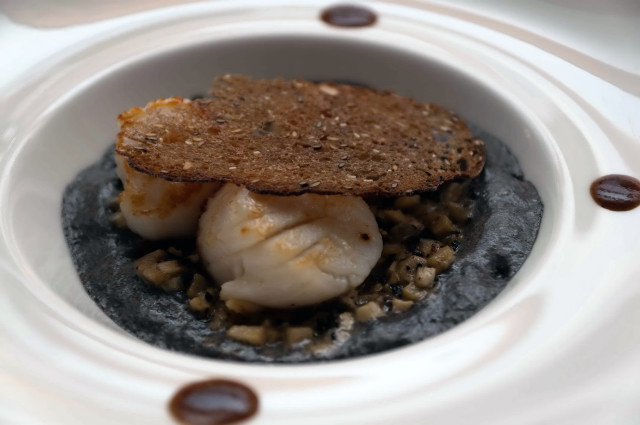
Second Course: My mom's Scallops recipe, Mushrooms and Black Truffle espuma
Scallops were the reason behind this second course. A shell which calls for limestone terroir wines (similar to the ones found in Burgundy or Champagne) to offer a perfect match. The Schoffweg 2008 from Marcel Deiss is the result of several grape varieties complanted on a limestone terroir located right above the Grand Cru Altenberg de Bergheim. The wine displays a nose of very ripe fruits, then tastes very mineral, with fat and a fine acidity. The finish is very long for this unusual wine. The Riesling Grand Cru Vieilles Vignes Furstentum 1989 from Paul Blanck was more typical: harvested very ripe with a dose of botrytis (we would have called it a late harvest in 1989), the has a very expressive and complex nose with aromas of honey, green tea, smoke, dried flowers, butter and hints of mushrooms. The mouth is delicate, riche and balanced with a medium body. With its intense minerals, the Shoffweg is a perfect and intense texture match with the scallop itself. But with the black truffle espuma and the mushroom, the aromatic complexity of the Furstentum creates a wonderful pairing of aromas and texture.
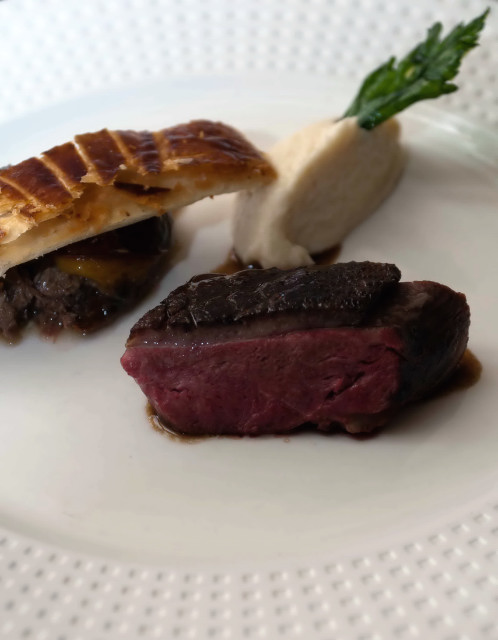
Third course: Duck served with a Plum Pie, Celery Mash
This rich dish was including the roasted duck breast with a thick sauce, served together with a pie prepared with duck meat, mushrooms and local Alsace plums called quetsches. Rich and powerful wines were required to match this power. I selected two pinot gris from two powerful terroirs. Pinot Gris Grand Cru Hengst 2007 from Domaine Albert Mann is a powerful wine coping from a powerful marly-limestone terroir (Hengst means Stallion in German). Pinot gris from this terroir are often described as white wines for Red wine lovers. 2007 is a high quality vintage on this growth, and this pinot gris was allowed a 125 days maturing period (instead of 100 days) before harvest, giving it a full maturity. Since botrytis did not develop so rapidly, the wine tastes nearly dry (only 20 grams per liter residual sugar). The result is a wonderful wine with delicate aromas of ripe fruits and vanilla, powerful and smooth, concentrated and fresh in the mouth with a very long finish. Still very young for its simple aromas, this wine is expected to keep well for the next 40 years at least. In a less powerful yet more violent style, Pinot Gris Grand Cru Rangen 2000 from Domaine Zind-Humbrecht was another legendary wine. Coming from the steep and volcanic Rangen Grand Cru in a very ripe year, the wine shows intense aromas of ripe kernel fruits, together with smoky and toasted aromas. Very rich on the palate with a long smoky finish, the wine is very typical from the best cuvees produced on this terroir. This wine will be a perfect match with the whole dish, especially the jammy and sweet character of the pie will help balance the sweetness of the wine, bringing together the meat and the volcanic character of the wine. The power of the Hengst wine will match the duck with the dough together with the celery mash, but the wine is not rich enough to support the plums. In both cases, here’s a perfect example of how white wines can match powerful dishes.
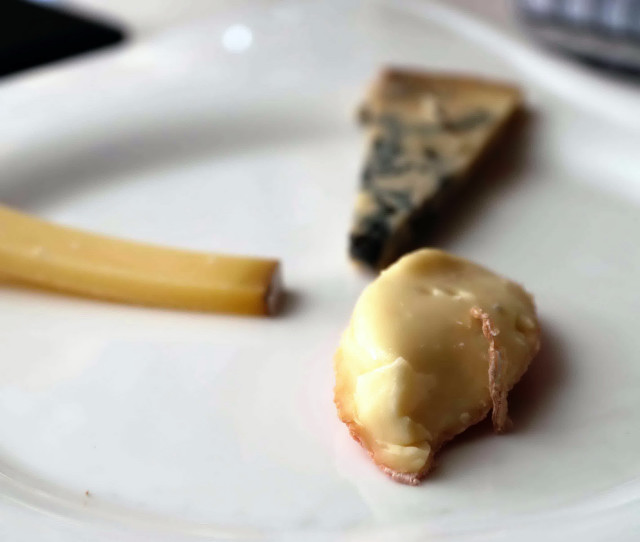
Fourth course: Cheese selection from Jacky Quesnot
Jacky Quesnot is a Maître Fromager based in Colmar, refining his own cheese selection. I brought Jacky the wines I had chosen and we tasted and selected the cheeses accordingly in his store. Gewurztraminer Grand Cru Mambourg 2005 from Marc Tempé is probably the most mineral wine produced in 2005, regardless of grape variety. An intense, exotic nose is followed by a truly explosion in the mouth which magnifies the marly limestone soil Mambourg as no one else does. As one participant noted, this wine is to Alsace terroir wines what Red Bull is to traditional sodas. Next to it the Riesling Vendanges Tardives 1995 from Hugel & Fils has complex aromas of honey, quince, citrus, candied fruits and dried flowers. In the mouth it is a very complex wine with a rich balance that magnifies the deep marly soil of Grand Cru Schoenenbourg. According to Etienne Hugel, the grapes were harvested on October 26, 1995. The Cheese selection includes a creamy Vacherin Mont d’Or, with a medium power which matched well with both wines, but also a dry Comté du Haut Jura, which makes the Riesling a perfect match, and a 12-month Stilton from London which was a truly extraordinary match with the Mambourg.
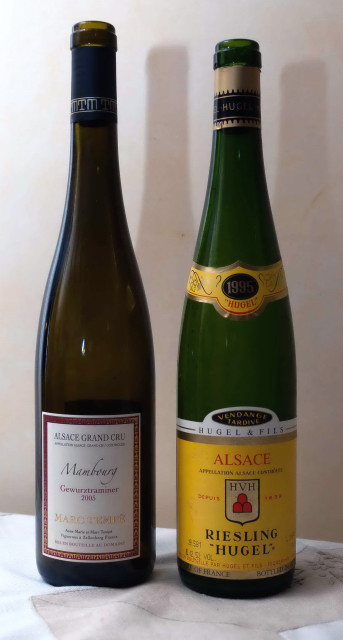
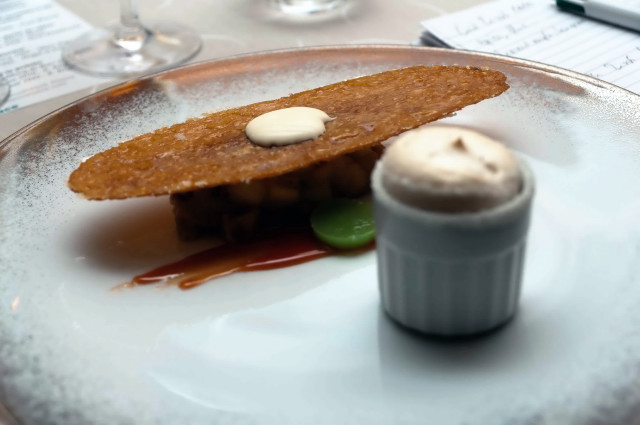
Fifth Course: Dessert around the Apple
The dessert was inspired by a recipe Bernard Leray used when he worked for Bernard Loiseau at restaurant La Côte d’Or in Saulieu. Apples prepared in various ways, crunchy or creamy, as soufflé or as compote, were offering an interesting set of textures. I wanted to share an older vintage wine to end of the evening, and The Klipfel domain made this possible. The estate has been growing wine on the Clos Zisser terroir, an area located within the Grand Cru Kirchberg de Barr. Clay and Limsetone make it possible to produce long-ageing wines, and the Kipfel house keeps a collection of old vintages produced during the last 80 years. The Gewurztraminer Grand Cru Kirchberg de Barr Clos Zisser Sélection de Grains Nobles 2010 from E. Klipfel is very typical of the great sweet wines produced in 2010 : very rich (close to 200 g/l residual sugar) with a strong acidity, the wine is still very young with fresh fruits aromas, and a straightforward yet powerful mouth. Several years of ageing will be required to gain the necessary complexity. On the other hand, the Tokay d’Alsace Clos Zisser 1942 from E. Klipfel is also a sweet wine produced before the SGN mention was regulated. With a darker color, aromas of leather, caramel, dried flowers, the wine is still tasting slightly sweet, and its baked apple finish makes it a delicate match to the dish. Many thanks to Jean-Louis and André Lorentz for providing us with the opportunity to taste sich a legendary wine.

Some Lessons learned
Beyond the intense pleasure provided by the meal, four remarks emerged as we were going through the five courses:
-
Drink young, drink mature, but drink appropriate: if some wines can benefit from several years of cellaring, the first years after bottling are also a good time to enjoy great wines, since they show their vibrant youth. This is especially interesting to match food with little cooking, such as raw of marinated fish and meat, salads and fresh cheeses. Don’t feel guilty to open 2010 or 2011 wines now, even if in most cases it will be good to store more bottles for later.
-
Grape variety is important, but think about terroir too when making pairing: wine and food pairing is not only about aromas, but also about texture and minerality. Beyond grape variety, and any combination of acidity and sweetness, terroir plays an important role in the complexity of the wine. Seafood is ideally paired with limestone terroirs, as these are made from sea sediments like shells. River or lake fishes will benefit from granite or limestone terroirs, less powerful that limestone. With cheese think marly terroirs, as they will often bring the density and suavity perfect to match the creamy side of the cheese.
-
Pairing with a dish requires considering the main ingredient but also the sauce and the side dishes: a wine and food pairing can be modified by adding the right sauce or the right side dish. Which allows to correct the dish if you already have the wine, for example adding some carrots mash to handle a slightly sweet wine for example. But you can also build your pairing by choosing the wine based on the dish: select the terroir based on the main ingredient, then choose the grape variety and the sweetness level based on the richness of the dish. Last, select a vintage to match the complexity of the dish, i.e. long cooking with sauces will call for older vintages.
-
Great Alsace wines are among the world’s greatest wines: as shown for this extraordinary dinner, when Alsace wines are at the top, they are probably among the very best wines of the world: the combination of power, complexity, minerality and balance make them perfect to match all kinds of food. And if you consider the high variety provided by all terroir types, grape varieties and maturity levels, Alsace wines are unmatched for such a high diversity.
If you are reading this and could not participate to the dinner, follow up on www.oenoalsace.com to learn about the next public dinners and tastings, or contact me to setup private events.
Thierry Meyer
(Thank you to Stephane Wasser for the dish and wine pictures)